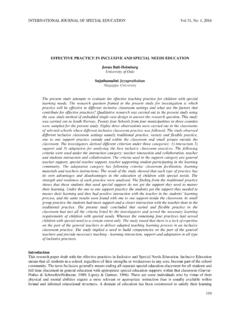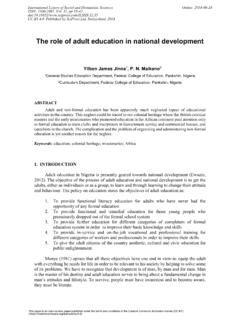Transcription of Two Perspectives on Inclusion In The United States
1 14 Global education Review 1(1) Global education Review is a publication of The School of education at Mercy College, New York. This is an Open Access article distributed under the terms of the Creative Commons Attribution-Noncommercial Unported License, permitting all non-commercial use, distribution, and reproduction in any medium, provided the original work is properly cited. Citation: Dudley-Marling, Curt & Burns, Mary Bridget (2014). Two Perspectives on Inclusion in The United States . Global education Review, 1 (1). 14-31 Two Perspectives on Inclusion In The United States Curt Dudley-Marling Boston College Mary Bridget Burns Boston College Abstract The history of schooling for students with disabilities in the United States is marked by exclusion and, until the passage of the education for All children Act in the 1970s, a substantial number of students with disabilities were denied free public education and many more were poorly served by public schools.
2 The requirement that all children be educated in the least restrictive environment gradually allowed many students with disabilities to be educated alongside their peers without disabilities and today a majority of students with disabilities spend more than 80% of their school days in regular classroom settings. Still, the meaning of Inclusion is bitterly disputed, fueled in large part by two contrasting views of disability. This paper discusses these two views a deficit stance and a social constructivist perspective and the effects of these views on the meaning of Inclusion , the purpose of Inclusion , and how inclusive education is achieved. Keywords Inclusion , equity, deficit perspective on Inclusion , social constructivist stance on Inclusion Introduction As we began writing this paper, the US Department of education issued a clarification regarding the legal obligations of school districts to provide access to sports for students with disabilities.
3 According to the new guidelines, school districts are required to provide a qualified student with a disability an opportunity to benefit from the school district s program equal to that of students without disabilities (in Pilon, 2013, p. D5). This ruling has been hailed by some as a significant moment in the movement to include students with disabilities into the normal life of US schools (Pilon, 2013). However, the history of education for students with disabilities in the United States has, until relatively recently, been marked by exclusion , not Inclusion . Prior to the enactment of the landmark education for All children Act (also known as Public Law 94-142), only one in five students with disabilities in the US were educated in public schools. Moreover, many States had laws on their books that explicitly excluded many students with disabilities from public schooling including children who had _____ Corresponding Author: Curt Dudley-Marling, Boston College Lynch School of education , Campion Hall,140 Commonwealth Ave.
4 , Chestnut Hill, MA 02467 Email: Two Perspectives on Inclusion in The United States 15 been labeled deaf, blind, emotionally disturbed, education Programs, 2007). Other States permitted public school programs for certain groups of students with disabilities but did not require it. Before the implementation of Public Law 94-142, New York State, for example, permitted school districts to provide an education to students with IQs below 50 (Harrison, 1958). In the early 1970s, over one million children with disabilities in the US were completely excluded from public education and another million were not receiving appropriate services (Martin, Martin, & Terman, 1996). This situation changed with the passage of PL 94-142 which mandated that all students with disabilities be provided with a free and appropriate education in the least restrictive environment (Osgood, 2005, p.
5 105). Today nearly all students with disabilities spend at least part of their day being educated alongside children without disabilities ( 31st Annual Report to Congress on the Implementation of the Individuals with Disabilities education Act, 2009). For some educators this represents a triumph of inclusive policies. Others view the increased presence of students with disabilities in regular educational settings merely as a step toward truly inclusive schools (Allen, 2006). These positions reflect fundamental differences in the meaning of Inclusion and the means for achieving inclusive schools. Fleshing out the meaning of Inclusion in an American context is the aim of this paper. We begin by offering a brief history of Inclusion in the United States drawing heavily on Robert Osgood s (2005) historical review of Inclusion in the US. We then turn our attention to explicating two positions on Inclusion that dominate discussions of Inclusion in the United States .
6 The first position we discuss is the deficit stance (sometimes referred to as the medical model) on disabilities that situates disabilities in the minds and bodies of students. We then consider the goals and rationale for Inclusion that derive from this perspective as well as the means for achieving Inclusion within a deficit framework. Next we take up a social constructivist view of disabilities that situates disabilities in the complex interaction between naturally occurring human differences and the sociocultural contexts of schooling. We then discuss the goals and rationale for Inclusion that emerge from a social constructivist framework and how Inclusion is achieved from this perspective. We give more space to the social constructivist perspective because it may be less familiar to many readers and because we find this stance more persuasive ourselves. History of Inclusion in The United States The history of special education is typically understood in terms of the inexorable movement toward the integration of students with disabilities into regular education settings (Ainscow, 1999).
7 Yet, the history of special education in the US has been marked mainly by segregation and exclusion . In his History of Inclusion in the United States , Robert Osgood (2005) observed that, until relatively recently, a significant proportion of students with disabilities in the US, especially students with intellectual disabilities, were considered uneducable. These students were completely excluded from public schooling. Even those students with disabilities who were considered to be educable were typically segregated within schools since it was presumed that these students had unique educational needs requiring the services of specially trained professionals. Historically educators resisted the integration of exceptional children who, because they did not fit into the rigid structures of American schooling, overtaxed the efficient operation of schools (p.)
8 24). The 16 Global education Review 1(1) assumption was that the Inclusion of students into regular educational settings would demand so much attention from teachers as to have a detrimental effect on the education of students without disabilities. Osgood cites instances of school superintendents who concluded that it was worth the higher costs of educating students with intellectual disabilities in segregated schools or classrooms given the negative effect their presence would have on the learning of normal children . As early as the late 19th century there were, however, a few exceptions to the pattern of segregation and exclusion of students with disabilities. Osgood cites, for example, the cases of Batavia, New York and Newton, Massachusetts where assistant or unassigned teachers provided support for s tudents with disabilities within regular classrooms.
9 Still, Osgood emphasizes that the dominant trend in well into the 20th century was the removal of students with disabilities from the regular classroom. In many cases, students with disabilities continued to be excluded from public schooling altogether although some States did pass enabling legislation during this time that permitted, but did not require, school districts to educate certain categories of students with disabilities within public schools. Despite the continuing pattern of exclusion and segregation of students with disabilities there were occasional calls that these students have at least social contact with children without disabilities. Some went even further. Osgood (2005) quotes principal and Illinois Council of Exceptional children member Edward Stullken who wrote in 1950s, in general, it is best not to segregate any individual by placement in a special group, if he may receive as good or better training in a normal group of pupils (p.)
10 45). Others began to question the efficacy of special class placement in general. In his classic article, Special education for the mildly retarded Is much of it justifiable? Lloyd Dunn (1968) argued that special education in its present form is obsolete and unjustifiable from the point of view of the pupils so placed (Dunn, 1968, p. 6). Dunn was particularly concerned about the overrepresentation of minority students in special education classes, a problem that persists in the US (see Harry & Klingner, 2005). Parental activism in the 1960s, along with court challenges to the practice of denying many children with disabilities a free public education , led to a rapid expansion of special education within public schools. For example, in Pennsylvania Association for Retarded children v. Commonwealth of Pennsylvania (1971) a group of parents of whose children had been identified as mentally retarded successfully challenged a state law that absolved school districts of responsibility for educating students deemed to be uneducable or untrainable (Osgood, 2005, p.












